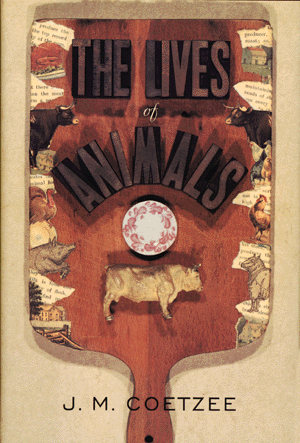Upon reading the two part lecture presented by J.M. Coetzee in his now published novel The Lives of Animals, I was able to understand why each of the critics had such a difficult time responding. I can, however, see how Coetzee’s writing develops and the patterns existent in many of his novels. One prime similarity we have seen in the novels we have read thus far, for example, is in terms of the dualistic elements presented in an attempt to both develop dual perspectives and to pose a social critique. We won’t after all understand the effectiveness or flaws on a concept or idea until we compare it with another. From similar novels we have read in class including In the Heart of the Country (slave/master discourse)and Waiting for the Barbarians (powerful/powerless and civilized and savage), we can see how the dualistic elements are either working against each other or are working in response to their binaries. In The Lives of Animals, dualistic elements are in play at different levels. As Marjorie Garber, for instance, writes, “Within the family…there is a distinction between the novelist and the philosopher, between Elizabeth [Costello]and Norma” (80). Garber then poses the question, “What is the structural relationship between…literature and philosophy” (80). Just in this short segment, we have multiple binaries. For one, Elizabeth Costello and Norma are very different characters. The only binding commonality among the two is John Bernard, son of Costello and husband of Norma. He always found himself in the middle of the two, always making an attempt to understand both. Part of the reason why they were each having such difficulties coming to terms with one another is based on their dualistic theoretic disciplines: literature vs. philosophy.
When thinking about the dualities discussed here (literature vs. philosophy), several questions come to mind. For instance, is it possible to separate literature from philosophy as two different entities or is the line too fine? To complicate this question even further, we can focus on professor of philosophy, Costica Bradatan’s question, “Is there any relationship between the literary forms philosophers [such as Plato] make use of and the specific methods through which they develop their thinking?” When developing philosophical pieces, not only is the theorizing important, but the way the theories are structured is important as well. Norma was a philosopher who thought of Costello’s perspective on the violence on animals as exaggerated, directive and at times underdeveloped. As a philosopher, Norma expected Costello too go deeper into her arguments, especially considering that was the prime focus of her lecture. As Peter Singer also adds, “I think she would go further than that. There’s a more radical egalitarianism about humans and animals running through her lecture than I would be prepared to defend” (86). Perhaps, Elizabeth Costello’s structure had to be carefully extracted to answer the philosophical questions that develop from her claims.
Bradatan, Costica. “ Syllabus.” Philosophy 100.11: Philosophy or Literature? The Literary Art of Philosophers. Web. 25 October 2011.
Coetzee, J.M. The Lives of Animals. Princeton, New Jersey: Princeton UP, 1999. Print.




